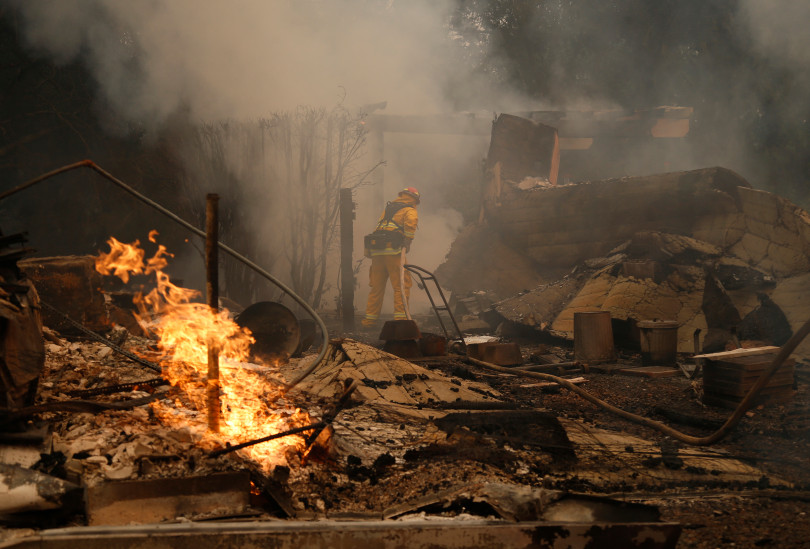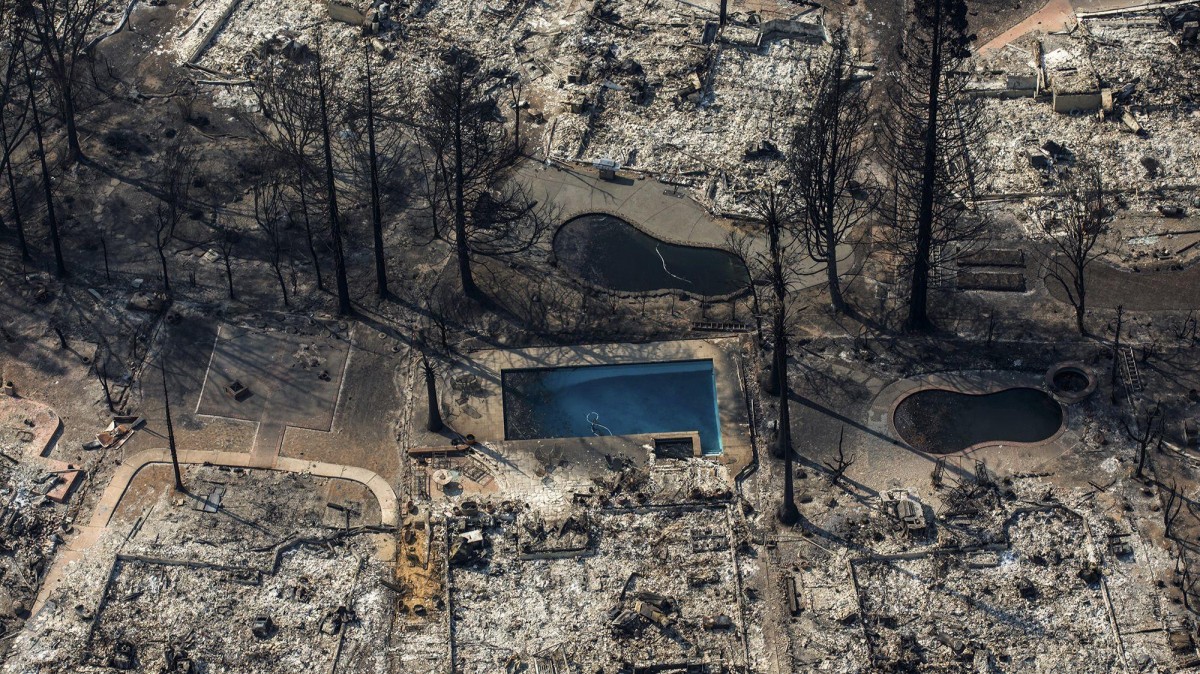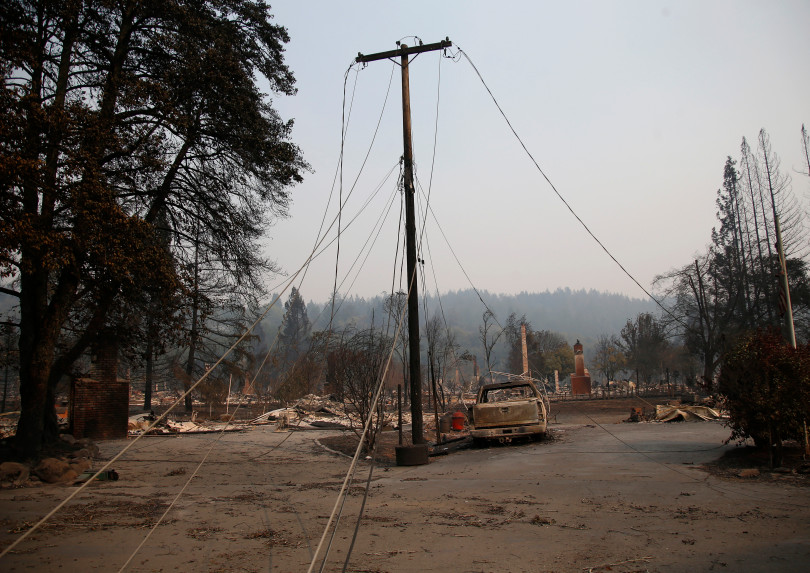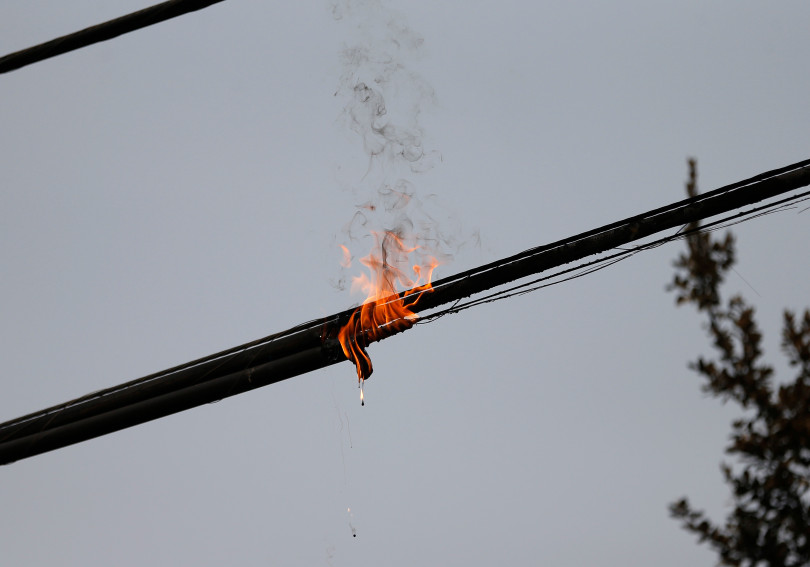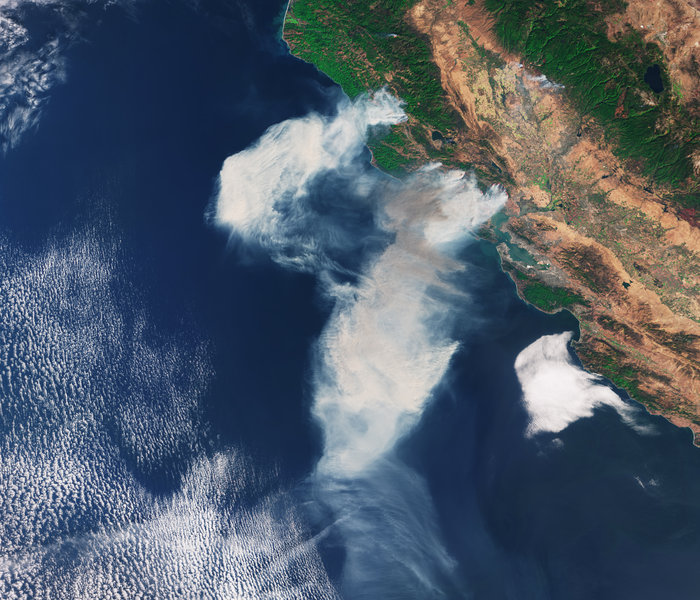As the first reports came in Sunday night of numerous fires that would grow into one of the most destructive wildfire disasters in California history, emergency dispatchers in Sonoma County received multiple calls of power lines falling down and electrical transformers exploding.
In all, according to a review of emergency radio traffic by the Bay Area News Group, Sonoma County dispatchers sent out fire crews to at least 10 different locations across the county over a 90-minute period starting at 9:22 pm to respond to 911 calls and other reports of sparking wires and problems with the county’s electrical system amid high winds.
State fire officials said Tuesday that they are still investigating the cause of the blazes, which as of late Thursday had killed 29 people and destroyed more than 2,000 homes in Sonoma, Napa and other Northern California counties.
But the reports of the power equipment failures began to turn the spotlight on PG&E, the giant San Francisco-based utility, raising questions about how well it maintained its equipment in the area and whether it adequately cut back trees from power lines to reduce fire risk — as required by state law.
PG&E officials issued a statement Tuesday evening, acknowledging the equipment troubles even as a company spokesman called the questions about maintenance “highly speculative.”
“The historic wind event that swept across PG&E service area late Sunday and early Monday packed hurricane-strength winds in excess of 75 mph in some cases,” said PG&E spokesman Matt Nauman.
“These destructive winds, along with millions of trees weakened by years of drought and recent renewed vegetation growth from winter storms, all contributed to some trees, branches and debris impacting our electric lines across the North Bay,” he added. “In some cases, we have found instances of wires down, broken poles and impacted infrastructure. Where those have occurred, we have reported them to the CPUC and CalFire. Our thoughts are with all those individuals who were impacted by these devastating wildfires.”
PG&E and other large utilities in California have a long history of being found responsible for major wildfires because of inadequate maintenance of their power lines.
In April, the state Public Utilities Commission fined PG&E $8.3 million for failing to maintain a power line that sparked the Butte Fire in Amador County in September 2015. That fire burned for 22 days, killing two people, destroying 549 homes and charring 70,868 acres.
CalFire announced last year that it will seek to force PG&E to pay $90 million in firefighting costs. More than 1,000 lawsuits and claims are still pending against the utility.
“It was more than just a lack of maintenance. It was a complete disregard for their requirements of vegetation management in rural areas,” said Burlingame attorney Frank Pitre, who sued on behalf of the victims.
Pitre said his law firm has already started fielding questions from Sonoma County residents who said they saw transformers exploding and downed wires sparking in their neighborhoods before they went up in flames. They wondered if the utility would be held liable, he said.
“This is very definitely on people’s radar of what caused a number of fires to break out all at once,” Pitre said.
“If downed wires are deemed the cause of the fire,” he added, “PG&E could be strictly liable for the cost of damages.”
In 1994, PG&E was found guilty of 739 counts of negligence and fined nearly $30 million by state regulators when trees touched its high-voltage wires in Nevada County in the Sierra foothills, sparking a fire near the town of Rough and Ready that destroyed 12 homes and a 19th century schoolhouse. Afterward, prosecutors found that PG&E had diverted nearly $80 million from its tree-cutting programs into profits.
State Sen. Jerry Hill, D-Redwood City, said he sees similarities in PG&E’s problems with maintaining its power lines to the utility’s failures to properly maintain its natural gas lines that led to the 2010 San Bruno explosion that killed eight people and destroyed 38 homes. PG&E was fined $1.6 billion by the PUC, and a federal jury last year convicted the company on five charges of violating federal pipeline safety regulations and one charge of obstructing an official National Transportation Safety Board probe into the blast.
“If it turns out that PG&E is responsible for this fire and negligent for not putting in the resources or for diverting the resources,” Hill said, “then I will be the first one to stand up and say we need to dissolve PG&E as a private company and form a public utility. We would not have the confidence or trust in them in the future. Nor should we.”
Officials for the PUC did not provide a safety official to answer questions Tuesday about the wine country fires, or PG&E’s records in maintaining its power lines and tree-trimming responsibilities.
“It may take some time for fire officials or utilities to determine the possible cause of the fires,” said Terrie Prosper, a spokeswoman for the PUC, which regulates big power companies such as PG&E. “Once that occurs, if it appears that a utility line may have been involved, the PUC will investigate.”
For multiple fires to all start around the same time in the middle of the night, lightning or arson could also have been a cause. But Ken Pimlott, chief of the California Department of Forestry and Fire Protection, ruled out lightning at a news conference on Tuesday.
Pimlott did, however, note the high winds.
“When we have a wind event like this — 50 mph winds bearing down on areas — every fire that starts has a significant potential to grow into a large fire very quickly,” he said.
According to Sonoma County fire radio traffic, after the first vegetation fire at 310 Buckingham Drive in the heart of Santa Rosa was reported at 9:22 p.m. Sunday, an electrical call went out seconds later at 1047 Maverick Court about 10 miles north. The next minute firefighters were sent to a “possible transformer explosion” at Fulton Road at Old Redwood Highway more than two miles west.
By 9:25 p.m., trees began falling at Ida Clayton Road in Calistoga, about 17 miles north. The downed power lines and trees continued as firefighters raced to a rapidly increasing number of structure and vegetation fires.
Not only did arcing wires and transformer problems potentially spark new fires, quickly spread by fierce winds, the downed trees blocked firefighters and emergency personnel from responding quickly. At about 9:52 p.m., a firefighter reported that Highway 128, in the center of the battle to contain the flames, was completely blocked by trees and branches. And Highway 101 access through the heart of Santa Rosa was shut down because of downed wires.
Frank Wolak, a professor of economics and an energy expert at Stanford University, said if PG&E’s lines are responsible, there will be a vigorous debate in front of the PUC about financial liability.
“My guess is that they will say no one expected the winds to be this strong for that long,” Wolak said. “If the PUC buys their story, then they aren’t liable. But if the PUC finds they were negligent, then they could have liability and penalties. If I were PG&E, I’d be very hopeful that I’d done everything the PUC had told me to do up there.”
Originally published by The Mercury News
3 WAYS TO SHOW YOUR SUPPORT
- Log in to post comments

